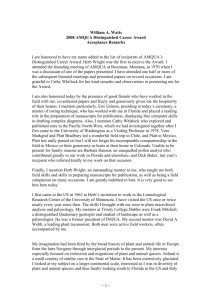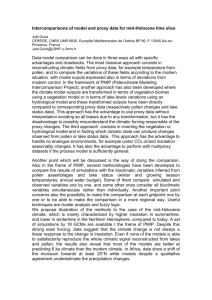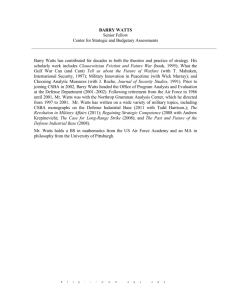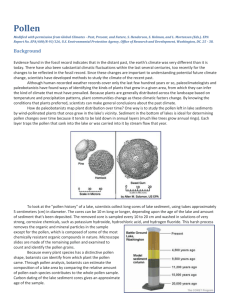here - AMQUA
advertisement
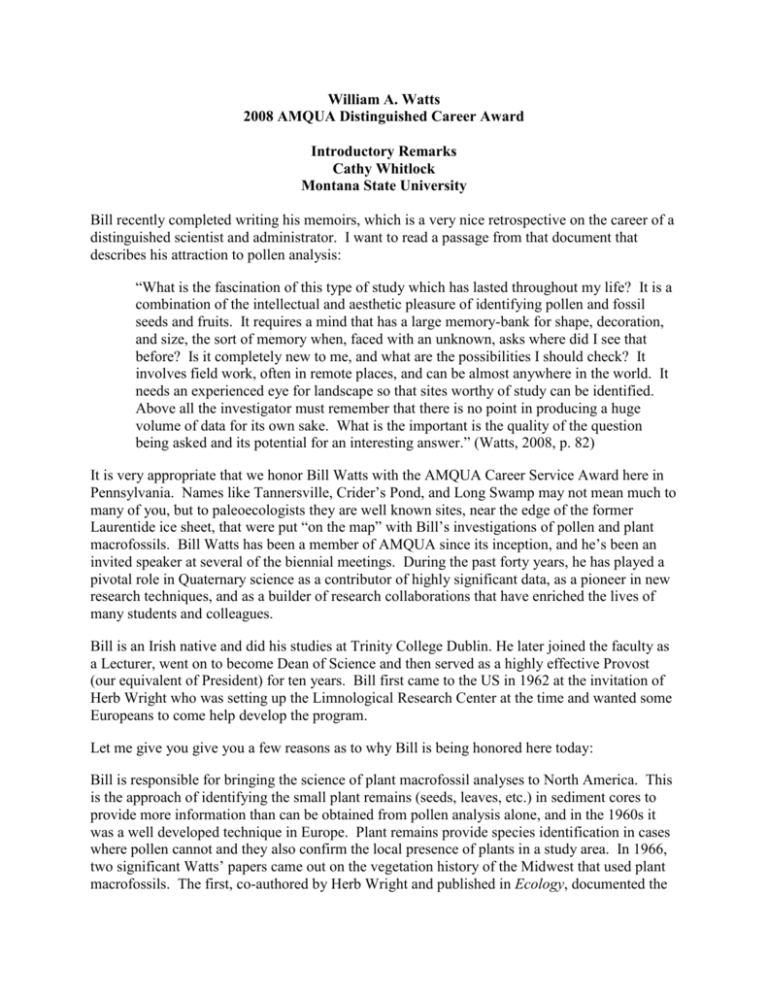
William A. Watts 2008 AMQUA Distinguished Career Award Introductory Remarks Cathy Whitlock Montana State University Bill recently completed writing his memoirs, which is a very nice retrospective on the career of a distinguished scientist and administrator. I want to read a passage from that document that describes his attraction to pollen analysis: “What is the fascination of this type of study which has lasted throughout my life? It is a combination of the intellectual and aesthetic pleasure of identifying pollen and fossil seeds and fruits. It requires a mind that has a large memory-bank for shape, decoration, and size, the sort of memory when, faced with an unknown, asks where did I see that before? Is it completely new to me, and what are the possibilities I should check? It involves field work, often in remote places, and can be almost anywhere in the world. It needs an experienced eye for landscape so that sites worthy of study can be identified. Above all the investigator must remember that there is no point in producing a huge volume of data for its own sake. What is the important is the quality of the question being asked and its potential for an interesting answer.” (Watts, 2008, p. 82) It is very appropriate that we honor Bill Watts with the AMQUA Career Service Award here in Pennsylvania. Names like Tannersville, Crider’s Pond, and Long Swamp may not mean much to many of you, but to paleoecologists they are well known sites, near the edge of the former Laurentide ice sheet, that were put “on the map” with Bill’s investigations of pollen and plant macrofossils. Bill Watts has been a member of AMQUA since its inception, and he’s been an invited speaker at several of the biennial meetings. During the past forty years, he has played a pivotal role in Quaternary science as a contributor of highly significant data, as a pioneer in new research techniques, and as a builder of research collaborations that have enriched the lives of many students and colleagues. Bill is an Irish native and did his studies at Trinity College Dublin. He later joined the faculty as a Lecturer, went on to become Dean of Science and then served as a highly effective Provost (our equivalent of President) for ten years. Bill first came to the US in 1962 at the invitation of Herb Wright who was setting up the Limnological Research Center at the time and wanted some Europeans to come help develop the program. Let me give you give you a few reasons as to why Bill is being honored here today: Bill is responsible for bringing the science of plant macrofossil analyses to North America. This is the approach of identifying the small plant remains (seeds, leaves, etc.) in sediment cores to provide more information than can be obtained from pollen analysis alone, and in the 1960s it was a well developed technique in Europe. Plant remains provide species identification in cases where pollen cannot and they also confirm the local presence of plants in a study area. In 1966, two significant Watts’ papers came out on the vegetation history of the Midwest that used plant macrofossils. The first, co-authored by Herb Wright and published in Ecology, documented the late-glacial presence of spruce (Picea glauca) at the Rosebud site in the Sandhills of Nebraska, far beyond spruce’s current range. It was dramatic evidence that species had traveled long distances across the continent at the end of the ice age in order to reach their present distribution. The second paper, with Tom Winter was published in Geological Society of America Bulletin. It demonstrated the value of macrofossils for reconstructing past environments at a now-famous site, Kirchner Marsh, Minnesota, where a number of dry periods were documented from changes in the macrofossils of aquatic plants. Two years later, a paper on another famous site, Pickerel Lake, co-authored with the late Robert C. Bright and also published in the GSA Bulletin, used pollen and macrofossils to infer the Holocene climates of northeastern South Dakota. The study showed that the region had been much drier in the middle Holocene and, as a result, lake-level had been lowered and waters were more salty. Second, many of us think about Bill Watt’s contributions in understanding the vegetation history of the southeastern US, and this work also began in the late 1960s. First, he published a pollen diagram from Mud Lake, Florida in GSA Bulletin in 1969. Over the next four decades, several important papers were published from previously unstudied regions from Florida to Pennsylvania. Conventional wisdom at the time was that the rich Appalachian forests were incredibly stable and had remained relatively intact during the Quaternary. Bill argued the contrary, and he, Margaret Davis, and Tom Webb led a revolution in paleoecology that spilled into field of ecology and is now the basis for our projections of plant distributions in the future. This revolution is based on the idea that plant communities are not stable and long lived, but rather dynamic and constantly changing as a result of climate change. I should add that Bill’s investigations of sites in Mexico, with Platt Bradbury, and Bermuda, with Barbara Hansen, added further geographic insights to this emerging picture of Quaternary change in North America. Another reason to honor Bill is that many of the long, great records of Europe and North America have been identified and studied by Bill. He has the Midas touch when it comes to picking a good site. Lake Annie, Florida, for example, revealed that with careful searching, lakes could be found that survived drying in the full-glacial. Later, Bill discovered Lake Tulane and, with Eric Grimm, has developed a record that spans at least 60,000 years. The second, Peace Creek, a filled sinkhole in Polk County, has sediments that likely date back to the Pliocene. In recent decades he has collaborated with British and German colleagues, he analyzed cores from Lago Grande di Monticchio in central Italy, which cover most of the last glacial/interglacial cycle. The data from Monticchio and Lake Tulane, Florida rank among the most important terrestrial sequences for comparison with high-resolution ice-cores and marine sediments. Finally, Bill’s personal qualities have earned him friendships around the world. His encouragement of colleagues and students has inspired many careers, including my own. I met Bill in 1978 when I was a graduate student at the University of Washington and he was a visiting professor teaching a course on paleoecology. He came out for the next few years. Bill got us all interested in the prospect of collected sediment cores from wetlands in the Pacific Northwest and soon a research group formed around these activities with people like Eric Grimm, Les Cwynar, Tom Davis, Rudy Nickmann, Herb Wright working on Northwest history. Many of us owe a lot to Bill. His interest in natural history (he is an excellent botanist and a very good birder), his promotion of careful laboratory analyses, and his persistence in seeking good sites, asking good questions, and discerning good ideas from bad, have provided positive examples for all to follow. For me, Bill has been an inspiration, mentor, and friend my entire career, and I can think of no one more deserving of this award. Please join me in congratulating Bill Watts. State College, PA June 6, 2008


